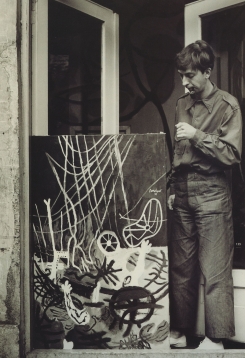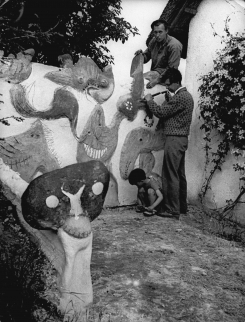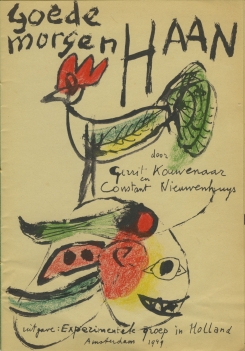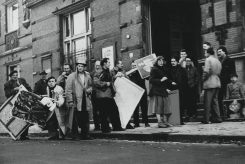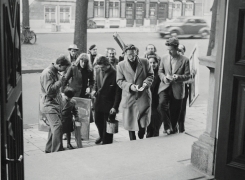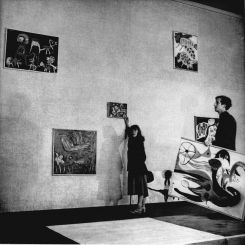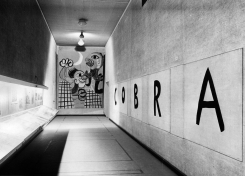Image
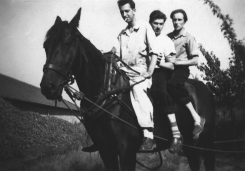
During the autumn of 1946 Constant Nieuwenhuys travels to Paris with his schoolfriend Hans Wiesman. Wiesman is send to Paris to do business for his father. He asks Constant to join him as an interpreter.
In Pierre Loeb’s gallery at Rue de Seine Constant meets the Danish painter Asger Jorn. They become friends and through Jorn he meets the Danish experimentalists, the Høst group. Together Jorn and Constant start the theoretical preparation of a movement that will be established two years later: CoBrA.
In 1947 Karel Appel and Corneille contact Constant because they feel a kinship between his work and theirs. On July 16th 1948 Karel Appel, Eugène Brands, Corneille, Constant, Jan Nieuwenhuys, Anton Rooskens and Theo Wolvecamp establish De Experimentele Groep in Holland (The Experimental Group in Holland) following the example of the Danish Høst Group. Later Gerrit Kouwenaar, Jan Elburg and Lucebert join the group. De Experimentele Groep in Holland publishes the magazine Reflex. In the first edition Manifest is published. Manifest is written by Constant and contains the quote:
Een schilderij is niet een bouwsel van kleuren en lijnen, maar een dier, een nacht, een schreeuw, een mens, of dat alles tezamen
A painting is not a mixture of colours and lines but an animal, a night, a scream, a human, or all that in one.
This quote paints a vivid picture of what the group strives for with their art. In his articles Constant pleads for a new society with modern art. He considers the perception of children and ‘primitives’ as the ideal way to express feelings.
Het kind kent geen andere wet dan zijn spontaan levensgevoel en heeft geen andere behoefte dan dit te uiten. Hetzelfde geldt voor de primitieve culturen, en het is deze eigenschap ook, die deze culturen een zo grote bekoring verleent voor de mens van heden die in een morbide sfeer van onechtheid, leugen en onvruchtbaarheid moet leven.
The child knows no other law than their spontaneous zest for life and has no other need than to express this. The same goes for primitive people. And it’s this quality that offers so much enchantment to modern man, living in a morbid atmosphere of inauthenticity, lies and barrenness
Constant is generally considered the theorist of the group. Throughout his career he continues to express strong social criticism through his work. He believes that art should be experimental. From experience (expérience) gained in absolute freedom comes a new creativity. Manifest will prove to be one of the most influential texts on art in the Netherlands after WWII. In Manifest Constant writes that the process of creation is more important than the creation itself. It’s a means to attain spiritual and mental affluence. The work of an experimental artist is a mirror image of the changes in the perception of beauty.
On November 8th 1948, on a terrace of café “Notre Dame” in Paris De Experimental Group in Holland meets with Christian Dotremont and Joseph Noiret from Belgium and Asger Jorn from Danmark after they abandon the international conference of the Centre International de Documentation sur l'Art d'Avant-garde, taking place November 5-7 in Paris. They leave the conference because they sense a lack of common ground between the French representatives of the surréalistes-révolutionnaires.
On this day Cobra is established by the signing of Dotremont's manifest by Asger Jorn (Copenhague), Dotremont (Brussels), Constant, Corneille and Appel (Amsterdam). With the manifest the members declare that they oppose to the declaration La cause était entendue (It's been decided) by the French Surrealists. The name CoBrA is contrived by Dotremont and consists of the first letters of the cities of the founding members: Copenhagen, Brussels and Amsterdam. The group opposes aesthetics in art and bourgeois art in general.
The group publishes a Cobra bulletin and artists from different disciplines join. In 1948 Constant and poet Gerrit Kouwenaar publish the collection of poetry Goede Morgen Haan. In 1949 the group has a large exhibition in the Stedelijk Museum Amsterdam and in 1951 in Liège.
Constant is very productive during the Cobra period. According to the artist himself he produces more paintings in that period than in the rest of his career after. Witte Vogel (White Bird) 1948, Laddertje (Little Ladder) 1949 and Verschroeide Aarde I (Scorched Earth) 1951 are a few examples of works from that period.
When Eugène Brands gets an exhibition at the Stedelijk Museum Amsterdam in november 1949 he invites the other Cobra artists to join him for a large group exhibition. Spring 1949 Corneille visits the Parisian Salon des Indépendants where he discovers the work of a Japanese sculptor from America. The work inspires him and he invites the sculptor, Shinkichi Tajiri to the exhibition in the Stedelijk Museum Amsterdam later that year. Shinkichi accepts and joins the exhibition as the representative from the United States. The contact between Shinkichi en Constant will result in a lifelong friendship and appreciation for each others work.
When the build up of the exhibition starts Sandberg realises that most of the artists don’t have money to create works at a large enough scale to fill the exhibition space. Eventually he advances them materials to produce large scale works. In a week Constant, Eugène Brands and Appel create some huge works of art that will become iconic for the Cobra group. Shinkichi, who has his worked shipped to the museum is forced to make some last minute repairs to his work which has come undone in the shipment. The architect, Aldo van Eyck, is asked for the interior design of the exhibition.
The exhibition is unconventional to say the least. The works of art as well as the way they are presented give rise to harsh criticism from press and public. A critic from Het Vrije Volk (Free People) writes 'Geklad, geklets en geklodder in het Stedelijk Museum' (Smirch, twaddle and mess in the SMA). An often heard remark from the public is that their children could probably do the same, only better. The Cobra artists are considered scribblers and con artists.
At the even larger exhibition in Liège in 1951, accompanied by the publication of the tenth edition of the CoBrA bulletin, the group dissolves itself. As Christian Dotremont, the international secretary, states in Museum News in 1962 the group would rather 'mourir en beauté' (die in beauty) than become a regular artist interest group. However short the existence of the group, CoBrA has forever changed the landscape of postwar European art.
Early Period 1920-1947
CoBrA 1948-1951
Towards a Synthesis of Art 1952-1956
New Babylon 1956-1974
Situationist International 1958-1960
Late Period 1974-2005

